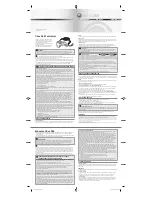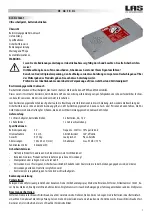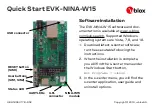
Command Description
ZB
Set feedback configuration.
DB Specify
deadband
value.
CL
Specify closed loop update interval.
Table 4.5: Closed Loop Stepper Positioning Commands
4.4
Synchronize Motion to External and Internal Events
4.4.1 Introduction – Synchronize Motion
Certain applications require the use of inputs from an external source
to command the motion controller to perform certain tasks. These
tasks can be to either initiate motion of desired axes (written in a
user's stored program) or to inhibit motion of desired axes or, more
simply, to just monitor the motion status of these axes. ESP series of
motion controller's address these issues by taking advantage of the
digital I/O interface available on the controller.
The 24 digital I/O bits are divided into three (3) ports: A, B, and C
(ESP100 and ESP300 motion controllers have access to only ports A
and B). Port A covers DIO bits 0 – 7, port B covers bits 8 – 15 and
port C covers bits 16 – 23.
The direction of each port can be setup to be either input or output. If
a port is configured to be an input, the DIO bits that belong to that
port can only report the state – HIGH or LOW logic level – of the
corresponding DIO hardware. On the other hand, if the port is
configured to be an output, the DIO bits in that port can be used to
either set or clear the state of the corresponding hardware. Each DIO
bit has a pull-up resistor to +5V. As a result, all bits will be at HIGH
logic if not connected to external circuit and configured as input.
Furthermore, the direction of all the ports is set to input by default
following a controller reset.
The next section details the way in which these DIO bits can be used
to initiate the motion of desired axes through stored programs. The
subsequent sections outline the way to inhibit the motion of desired
axes and to monitor the motion status of these axes using DIO bits.
4.4.2 Using DIO to Execute Stored Programs
ESP series of motion controllers can synchronize the initiation of any
motion profile to external events. In order to accomplish this task,
users must write their desired motion profile as a stored program and
assign this stored program to a desired DIO bit.
4-12
Section
4
–
Advanced
Capabilities
Содержание ESP300 Series
Страница 1: ...ESP300 Motion Controller Driver User s Manual...
Страница 4: ...ESP300 1999 EU Declaration of Conformity iv Preface...
Страница 29: ...This page is intentionally left blank Section 2 Modes of Operation 1 15...
Страница 30: ......
Страница 230: ...4 16 Section 4 Advanced Capabilities...
Страница 274: ...This page is intentionally left blank 6 6 Section 6 Servo Tuning...
Страница 290: ...This page is intentionally left blank B 6 Appendix B Trouble Shooting and Maintenance...
















































